Qbic Hotel: Leader and Manager Roles, Theories, and Operational Impact
VerifiedAdded on 2020/10/04
|15
|5075
|28
Report
AI Summary
This report delves into the contrasting roles of leaders and managers within a business context, specifically using Qbic Hotel as a case study. It begins by comparing the characteristics and responsibilities of leaders and managers, highlighting their differing approaches to vision creation, planning, and employee motivation. The report then examines how leaders and managers apply their skills in various situational contexts, such as implementing changes, increasing sales, and developing products, alongside the strengths and weaknesses associated with each approach. Furthermore, it explores different leadership models and theories, with a focus on the situational leadership model. The report also analyzes the impact of internal factors on operational management and the decision-making processes of leaders and managers within the organization. The conclusion summarizes the key findings and emphasizes the importance of effective operational management for business success.
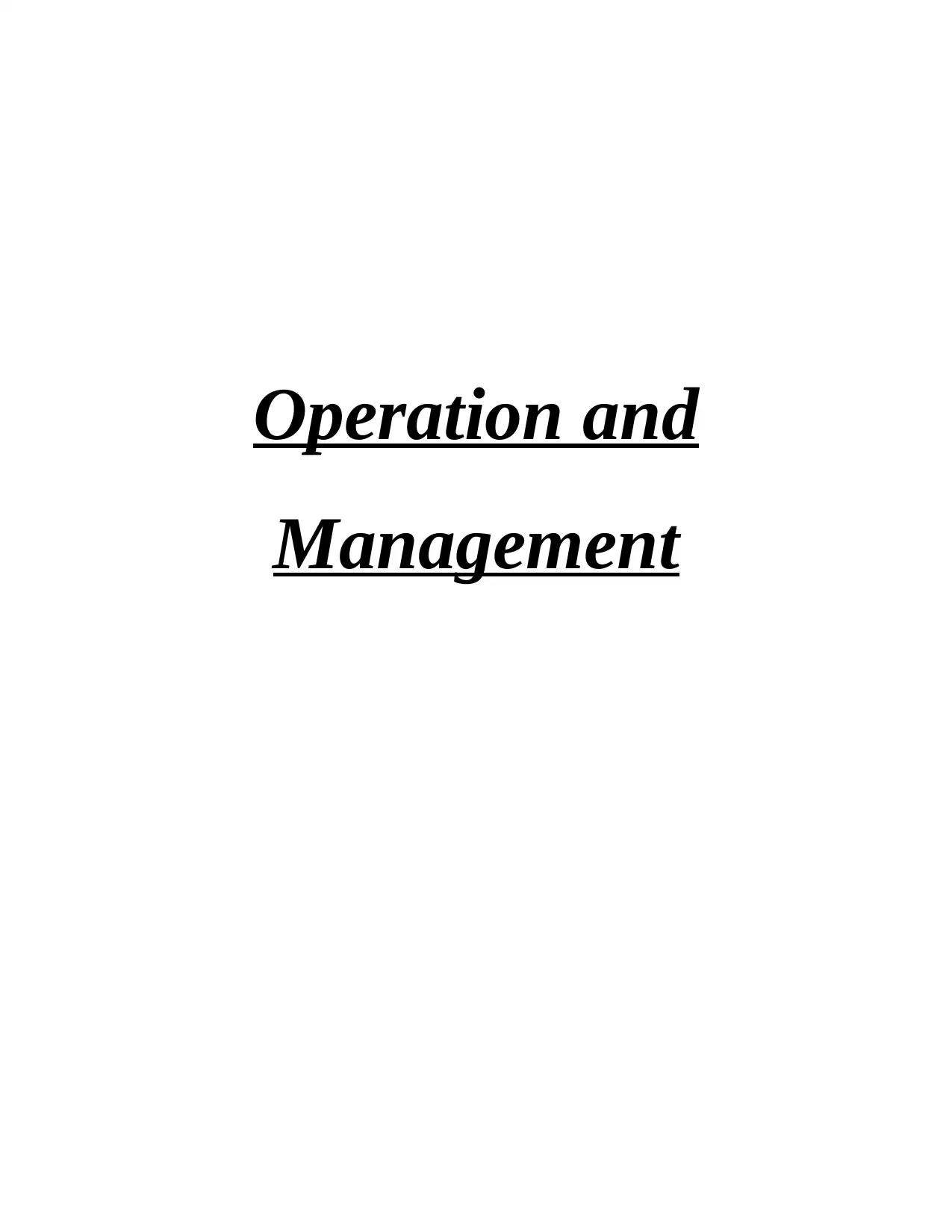
Operation and
Management
Management
Paraphrase This Document
Need a fresh take? Get an instant paraphrase of this document with our AI Paraphraser
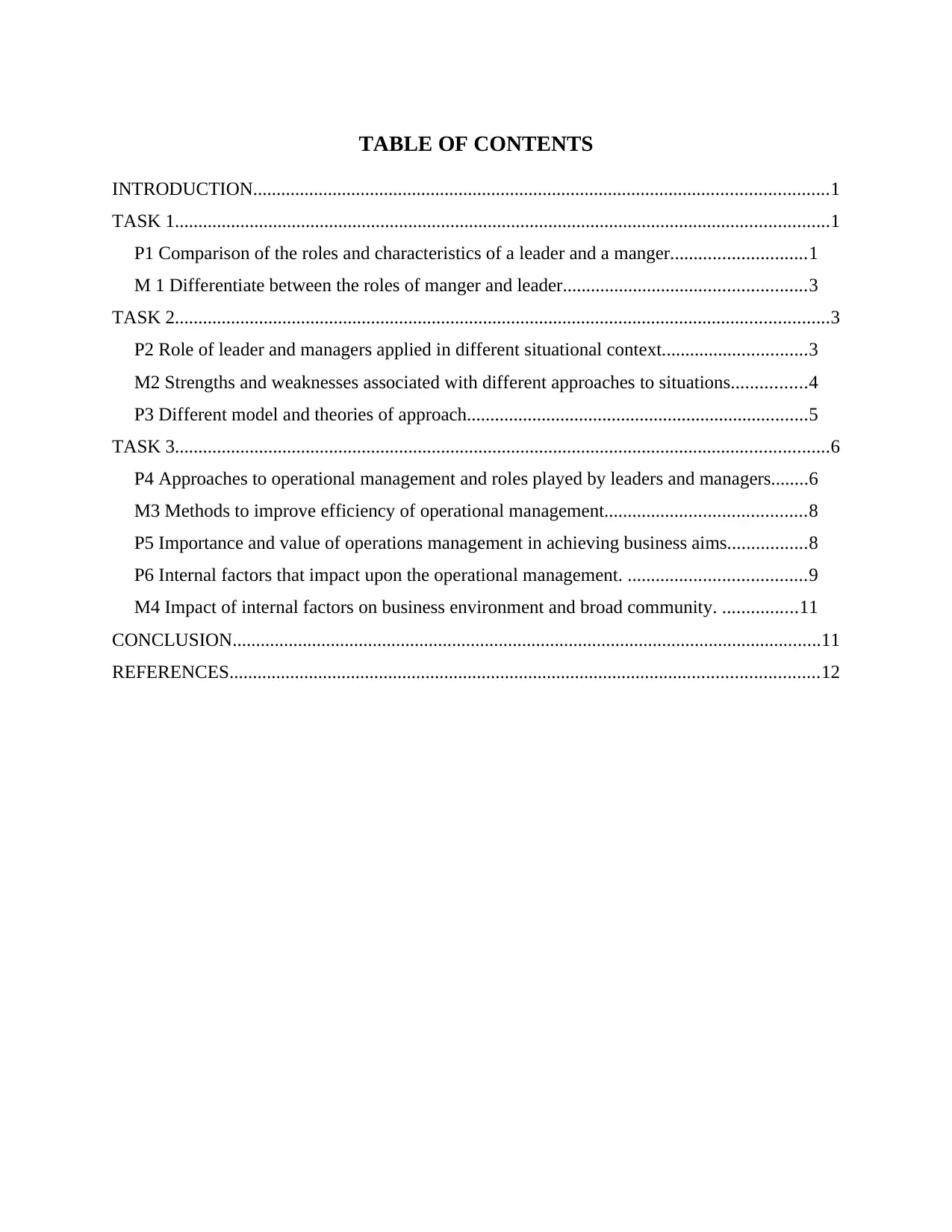
TABLE OF CONTENTS
INTRODUCTION...........................................................................................................................1
TASK 1............................................................................................................................................1
P1 Comparison of the roles and characteristics of a leader and a manger.............................1
M 1 Differentiate between the roles of manger and leader....................................................3
TASK 2............................................................................................................................................3
P2 Role of leader and managers applied in different situational context...............................3
M2 Strengths and weaknesses associated with different approaches to situations................4
P3 Different model and theories of approach.........................................................................5
TASK 3............................................................................................................................................6
P4 Approaches to operational management and roles played by leaders and managers........6
M3 Methods to improve efficiency of operational management...........................................8
P5 Importance and value of operations management in achieving business aims.................8
P6 Internal factors that impact upon the operational management. ......................................9
M4 Impact of internal factors on business environment and broad community. ................11
CONCLUSION..............................................................................................................................11
REFERENCES..............................................................................................................................12
INTRODUCTION...........................................................................................................................1
TASK 1............................................................................................................................................1
P1 Comparison of the roles and characteristics of a leader and a manger.............................1
M 1 Differentiate between the roles of manger and leader....................................................3
TASK 2............................................................................................................................................3
P2 Role of leader and managers applied in different situational context...............................3
M2 Strengths and weaknesses associated with different approaches to situations................4
P3 Different model and theories of approach.........................................................................5
TASK 3............................................................................................................................................6
P4 Approaches to operational management and roles played by leaders and managers........6
M3 Methods to improve efficiency of operational management...........................................8
P5 Importance and value of operations management in achieving business aims.................8
P6 Internal factors that impact upon the operational management. ......................................9
M4 Impact of internal factors on business environment and broad community. ................11
CONCLUSION..............................................................................................................................11
REFERENCES..............................................................................................................................12
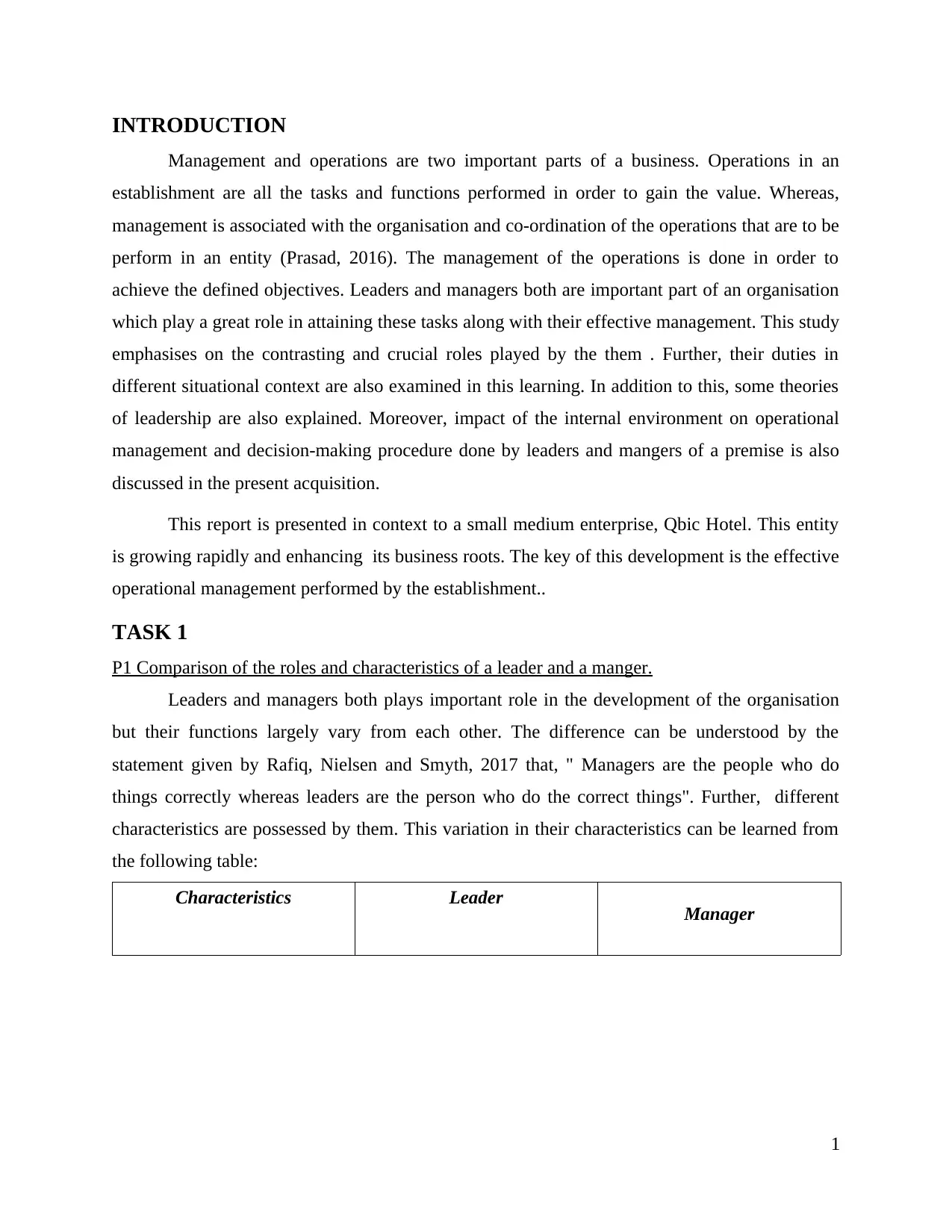
INTRODUCTION
Management and operations are two important parts of a business. Operations in an
establishment are all the tasks and functions performed in order to gain the value. Whereas,
management is associated with the organisation and co-ordination of the operations that are to be
perform in an entity (Prasad, 2016). The management of the operations is done in order to
achieve the defined objectives. Leaders and managers both are important part of an organisation
which play a great role in attaining these tasks along with their effective management. This study
emphasises on the contrasting and crucial roles played by the them . Further, their duties in
different situational context are also examined in this learning. In addition to this, some theories
of leadership are also explained. Moreover, impact of the internal environment on operational
management and decision-making procedure done by leaders and mangers of a premise is also
discussed in the present acquisition.
This report is presented in context to a small medium enterprise, Qbic Hotel. This entity
is growing rapidly and enhancing its business roots. The key of this development is the effective
operational management performed by the establishment..
TASK 1
P1 Comparison of the roles and characteristics of a leader and a manger.
Leaders and managers both plays important role in the development of the organisation
but their functions largely vary from each other. The difference can be understood by the
statement given by Rafiq, Nielsen and Smyth, 2017 that, " Managers are the people who do
things correctly whereas leaders are the person who do the correct things". Further, different
characteristics are possessed by them. This variation in their characteristics can be learned from
the following table:
Characteristics Leader Manager
1
Management and operations are two important parts of a business. Operations in an
establishment are all the tasks and functions performed in order to gain the value. Whereas,
management is associated with the organisation and co-ordination of the operations that are to be
perform in an entity (Prasad, 2016). The management of the operations is done in order to
achieve the defined objectives. Leaders and managers both are important part of an organisation
which play a great role in attaining these tasks along with their effective management. This study
emphasises on the contrasting and crucial roles played by the them . Further, their duties in
different situational context are also examined in this learning. In addition to this, some theories
of leadership are also explained. Moreover, impact of the internal environment on operational
management and decision-making procedure done by leaders and mangers of a premise is also
discussed in the present acquisition.
This report is presented in context to a small medium enterprise, Qbic Hotel. This entity
is growing rapidly and enhancing its business roots. The key of this development is the effective
operational management performed by the establishment..
TASK 1
P1 Comparison of the roles and characteristics of a leader and a manger.
Leaders and managers both plays important role in the development of the organisation
but their functions largely vary from each other. The difference can be understood by the
statement given by Rafiq, Nielsen and Smyth, 2017 that, " Managers are the people who do
things correctly whereas leaders are the person who do the correct things". Further, different
characteristics are possessed by them. This variation in their characteristics can be learned from
the following table:
Characteristics Leader Manager
1
⊘ This is a preview!⊘
Do you want full access?
Subscribe today to unlock all pages.

Trusted by 1+ million students worldwide
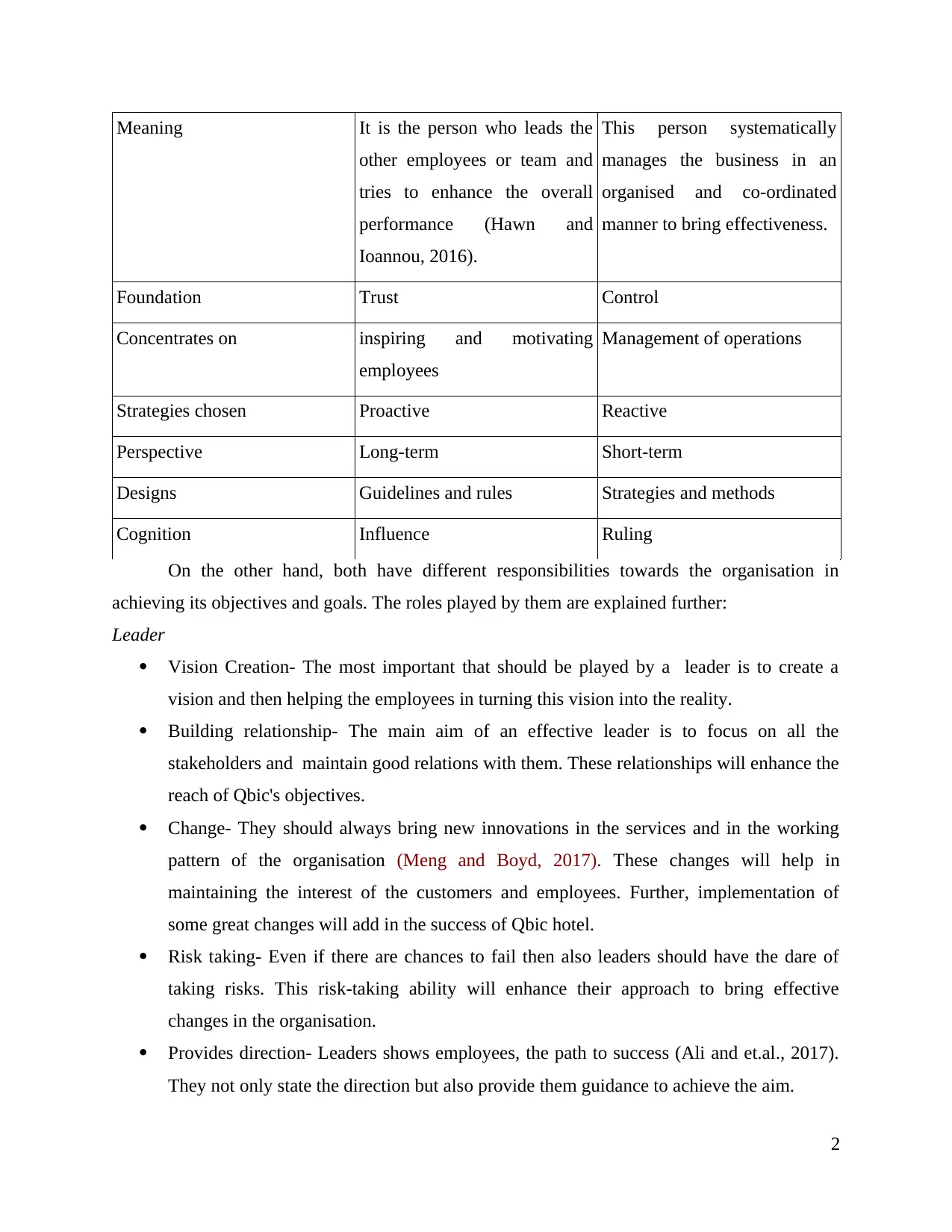
Meaning It is the person who leads the
other employees or team and
tries to enhance the overall
performance (Hawn and
Ioannou, 2016).
This person systematically
manages the business in an
organised and co-ordinated
manner to bring effectiveness.
Foundation Trust Control
Concentrates on inspiring and motivating
employees
Management of operations
Strategies chosen Proactive Reactive
Perspective Long-term Short-term
Designs Guidelines and rules Strategies and methods
Cognition Influence Ruling
On the other hand, both have different responsibilities towards the organisation in
achieving its objectives and goals. The roles played by them are explained further:
Leader
Vision Creation- The most important that should be played by a leader is to create a
vision and then helping the employees in turning this vision into the reality.
Building relationship- The main aim of an effective leader is to focus on all the
stakeholders and maintain good relations with them. These relationships will enhance the
reach of Qbic's objectives.
Change- They should always bring new innovations in the services and in the working
pattern of the organisation (Meng and Boyd, 2017). These changes will help in
maintaining the interest of the customers and employees. Further, implementation of
some great changes will add in the success of Qbic hotel.
Risk taking- Even if there are chances to fail then also leaders should have the dare of
taking risks. This risk-taking ability will enhance their approach to bring effective
changes in the organisation.
Provides direction- Leaders shows employees, the path to success (Ali and et.al., 2017).
They not only state the direction but also provide them guidance to achieve the aim.
2
other employees or team and
tries to enhance the overall
performance (Hawn and
Ioannou, 2016).
This person systematically
manages the business in an
organised and co-ordinated
manner to bring effectiveness.
Foundation Trust Control
Concentrates on inspiring and motivating
employees
Management of operations
Strategies chosen Proactive Reactive
Perspective Long-term Short-term
Designs Guidelines and rules Strategies and methods
Cognition Influence Ruling
On the other hand, both have different responsibilities towards the organisation in
achieving its objectives and goals. The roles played by them are explained further:
Leader
Vision Creation- The most important that should be played by a leader is to create a
vision and then helping the employees in turning this vision into the reality.
Building relationship- The main aim of an effective leader is to focus on all the
stakeholders and maintain good relations with them. These relationships will enhance the
reach of Qbic's objectives.
Change- They should always bring new innovations in the services and in the working
pattern of the organisation (Meng and Boyd, 2017). These changes will help in
maintaining the interest of the customers and employees. Further, implementation of
some great changes will add in the success of Qbic hotel.
Risk taking- Even if there are chances to fail then also leaders should have the dare of
taking risks. This risk-taking ability will enhance their approach to bring effective
changes in the organisation.
Provides direction- Leaders shows employees, the path to success (Ali and et.al., 2017).
They not only state the direction but also provide them guidance to achieve the aim.
2
Paraphrase This Document
Need a fresh take? Get an instant paraphrase of this document with our AI Paraphraser
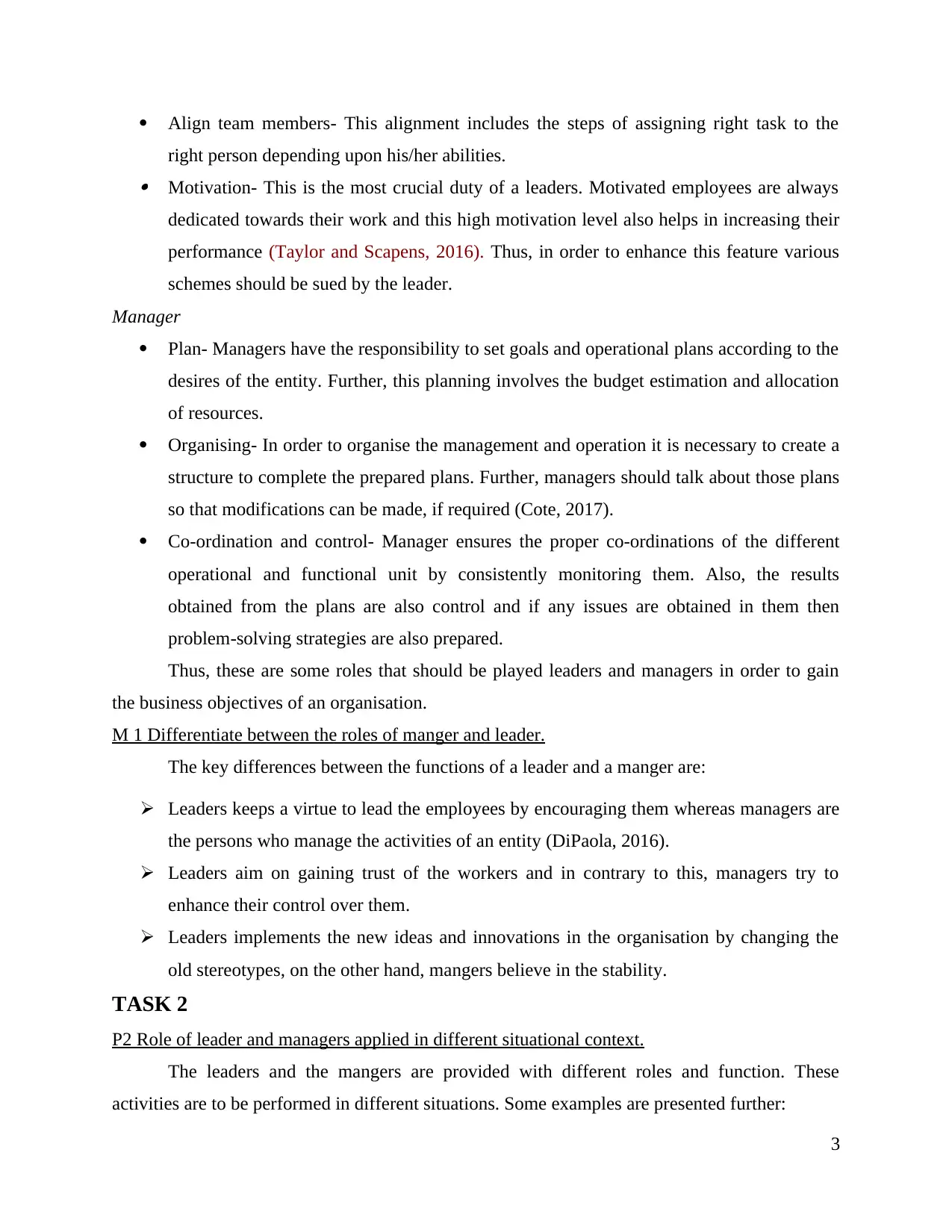
Align team members- This alignment includes the steps of assigning right task to the
right person depending upon his/her abilities. Motivation- This is the most crucial duty of a leaders. Motivated employees are always
dedicated towards their work and this high motivation level also helps in increasing their
performance (Taylor and Scapens, 2016). Thus, in order to enhance this feature various
schemes should be sued by the leader.
Manager
Plan- Managers have the responsibility to set goals and operational plans according to the
desires of the entity. Further, this planning involves the budget estimation and allocation
of resources.
Organising- In order to organise the management and operation it is necessary to create a
structure to complete the prepared plans. Further, managers should talk about those plans
so that modifications can be made, if required (Cote, 2017).
Co-ordination and control- Manager ensures the proper co-ordinations of the different
operational and functional unit by consistently monitoring them. Also, the results
obtained from the plans are also control and if any issues are obtained in them then
problem-solving strategies are also prepared.
Thus, these are some roles that should be played leaders and managers in order to gain
the business objectives of an organisation.
M 1 Differentiate between the roles of manger and leader.
The key differences between the functions of a leader and a manger are:
Leaders keeps a virtue to lead the employees by encouraging them whereas managers are
the persons who manage the activities of an entity (DiPaola, 2016).
Leaders aim on gaining trust of the workers and in contrary to this, managers try to
enhance their control over them.
Leaders implements the new ideas and innovations in the organisation by changing the
old stereotypes, on the other hand, mangers believe in the stability.
TASK 2
P2 Role of leader and managers applied in different situational context.
The leaders and the mangers are provided with different roles and function. These
activities are to be performed in different situations. Some examples are presented further:
3
right person depending upon his/her abilities. Motivation- This is the most crucial duty of a leaders. Motivated employees are always
dedicated towards their work and this high motivation level also helps in increasing their
performance (Taylor and Scapens, 2016). Thus, in order to enhance this feature various
schemes should be sued by the leader.
Manager
Plan- Managers have the responsibility to set goals and operational plans according to the
desires of the entity. Further, this planning involves the budget estimation and allocation
of resources.
Organising- In order to organise the management and operation it is necessary to create a
structure to complete the prepared plans. Further, managers should talk about those plans
so that modifications can be made, if required (Cote, 2017).
Co-ordination and control- Manager ensures the proper co-ordinations of the different
operational and functional unit by consistently monitoring them. Also, the results
obtained from the plans are also control and if any issues are obtained in them then
problem-solving strategies are also prepared.
Thus, these are some roles that should be played leaders and managers in order to gain
the business objectives of an organisation.
M 1 Differentiate between the roles of manger and leader.
The key differences between the functions of a leader and a manger are:
Leaders keeps a virtue to lead the employees by encouraging them whereas managers are
the persons who manage the activities of an entity (DiPaola, 2016).
Leaders aim on gaining trust of the workers and in contrary to this, managers try to
enhance their control over them.
Leaders implements the new ideas and innovations in the organisation by changing the
old stereotypes, on the other hand, mangers believe in the stability.
TASK 2
P2 Role of leader and managers applied in different situational context.
The leaders and the mangers are provided with different roles and function. These
activities are to be performed in different situations. Some examples are presented further:
3
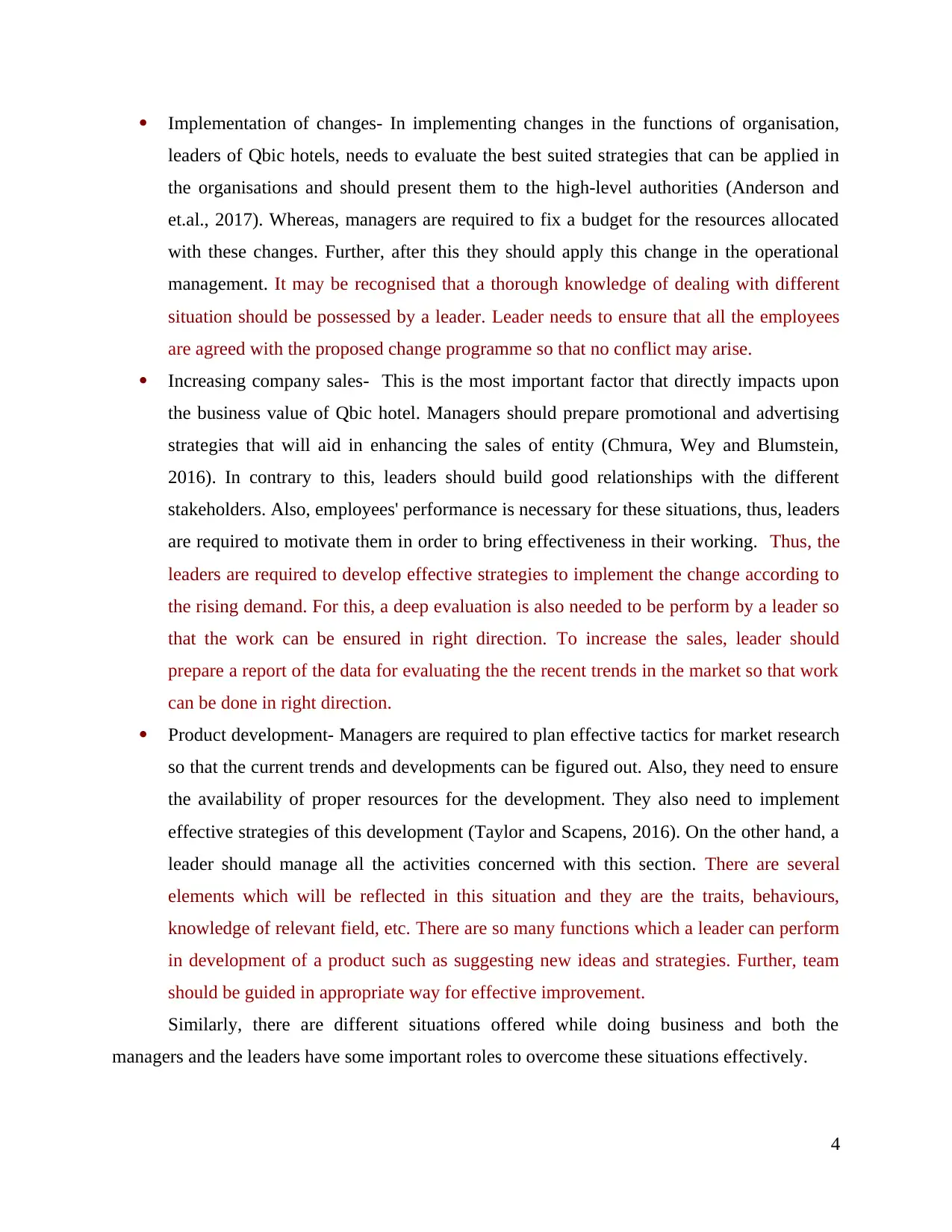
Implementation of changes- In implementing changes in the functions of organisation,
leaders of Qbic hotels, needs to evaluate the best suited strategies that can be applied in
the organisations and should present them to the high-level authorities (Anderson and
et.al., 2017). Whereas, managers are required to fix a budget for the resources allocated
with these changes. Further, after this they should apply this change in the operational
management. It may be recognised that a thorough knowledge of dealing with different
situation should be possessed by a leader. Leader needs to ensure that all the employees
are agreed with the proposed change programme so that no conflict may arise.
Increasing company sales- This is the most important factor that directly impacts upon
the business value of Qbic hotel. Managers should prepare promotional and advertising
strategies that will aid in enhancing the sales of entity (Chmura, Wey and Blumstein,
2016). In contrary to this, leaders should build good relationships with the different
stakeholders. Also, employees' performance is necessary for these situations, thus, leaders
are required to motivate them in order to bring effectiveness in their working. Thus, the
leaders are required to develop effective strategies to implement the change according to
the rising demand. For this, a deep evaluation is also needed to be perform by a leader so
that the work can be ensured in right direction. To increase the sales, leader should
prepare a report of the data for evaluating the the recent trends in the market so that work
can be done in right direction.
Product development- Managers are required to plan effective tactics for market research
so that the current trends and developments can be figured out. Also, they need to ensure
the availability of proper resources for the development. They also need to implement
effective strategies of this development (Taylor and Scapens, 2016). On the other hand, a
leader should manage all the activities concerned with this section. There are several
elements which will be reflected in this situation and they are the traits, behaviours,
knowledge of relevant field, etc. There are so many functions which a leader can perform
in development of a product such as suggesting new ideas and strategies. Further, team
should be guided in appropriate way for effective improvement.
Similarly, there are different situations offered while doing business and both the
managers and the leaders have some important roles to overcome these situations effectively.
4
leaders of Qbic hotels, needs to evaluate the best suited strategies that can be applied in
the organisations and should present them to the high-level authorities (Anderson and
et.al., 2017). Whereas, managers are required to fix a budget for the resources allocated
with these changes. Further, after this they should apply this change in the operational
management. It may be recognised that a thorough knowledge of dealing with different
situation should be possessed by a leader. Leader needs to ensure that all the employees
are agreed with the proposed change programme so that no conflict may arise.
Increasing company sales- This is the most important factor that directly impacts upon
the business value of Qbic hotel. Managers should prepare promotional and advertising
strategies that will aid in enhancing the sales of entity (Chmura, Wey and Blumstein,
2016). In contrary to this, leaders should build good relationships with the different
stakeholders. Also, employees' performance is necessary for these situations, thus, leaders
are required to motivate them in order to bring effectiveness in their working. Thus, the
leaders are required to develop effective strategies to implement the change according to
the rising demand. For this, a deep evaluation is also needed to be perform by a leader so
that the work can be ensured in right direction. To increase the sales, leader should
prepare a report of the data for evaluating the the recent trends in the market so that work
can be done in right direction.
Product development- Managers are required to plan effective tactics for market research
so that the current trends and developments can be figured out. Also, they need to ensure
the availability of proper resources for the development. They also need to implement
effective strategies of this development (Taylor and Scapens, 2016). On the other hand, a
leader should manage all the activities concerned with this section. There are several
elements which will be reflected in this situation and they are the traits, behaviours,
knowledge of relevant field, etc. There are so many functions which a leader can perform
in development of a product such as suggesting new ideas and strategies. Further, team
should be guided in appropriate way for effective improvement.
Similarly, there are different situations offered while doing business and both the
managers and the leaders have some important roles to overcome these situations effectively.
4
⊘ This is a preview!⊘
Do you want full access?
Subscribe today to unlock all pages.

Trusted by 1+ million students worldwide
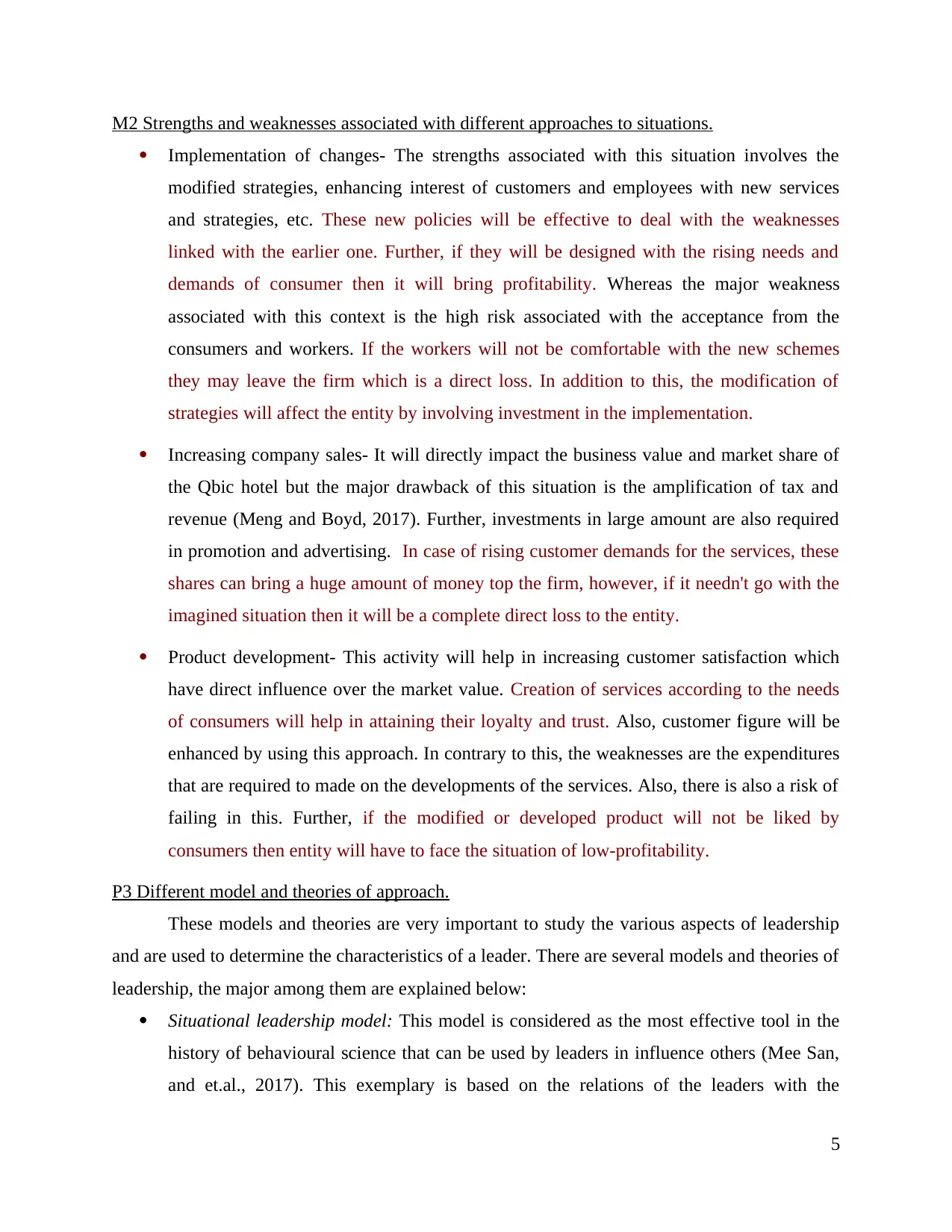
M2 Strengths and weaknesses associated with different approaches to situations.
Implementation of changes- The strengths associated with this situation involves the
modified strategies, enhancing interest of customers and employees with new services
and strategies, etc. These new policies will be effective to deal with the weaknesses
linked with the earlier one. Further, if they will be designed with the rising needs and
demands of consumer then it will bring profitability. Whereas the major weakness
associated with this context is the high risk associated with the acceptance from the
consumers and workers. If the workers will not be comfortable with the new schemes
they may leave the firm which is a direct loss. In addition to this, the modification of
strategies will affect the entity by involving investment in the implementation.
Increasing company sales- It will directly impact the business value and market share of
the Qbic hotel but the major drawback of this situation is the amplification of tax and
revenue (Meng and Boyd, 2017). Further, investments in large amount are also required
in promotion and advertising. In case of rising customer demands for the services, these
shares can bring a huge amount of money top the firm, however, if it needn't go with the
imagined situation then it will be a complete direct loss to the entity.
Product development- This activity will help in increasing customer satisfaction which
have direct influence over the market value. Creation of services according to the needs
of consumers will help in attaining their loyalty and trust. Also, customer figure will be
enhanced by using this approach. In contrary to this, the weaknesses are the expenditures
that are required to made on the developments of the services. Also, there is also a risk of
failing in this. Further, if the modified or developed product will not be liked by
consumers then entity will have to face the situation of low-profitability.
P3 Different model and theories of approach.
These models and theories are very important to study the various aspects of leadership
and are used to determine the characteristics of a leader. There are several models and theories of
leadership, the major among them are explained below:
Situational leadership model: This model is considered as the most effective tool in the
history of behavioural science that can be used by leaders in influence others (Mee San,
and et.al., 2017). This exemplary is based on the relations of the leaders with the
5
Implementation of changes- The strengths associated with this situation involves the
modified strategies, enhancing interest of customers and employees with new services
and strategies, etc. These new policies will be effective to deal with the weaknesses
linked with the earlier one. Further, if they will be designed with the rising needs and
demands of consumer then it will bring profitability. Whereas the major weakness
associated with this context is the high risk associated with the acceptance from the
consumers and workers. If the workers will not be comfortable with the new schemes
they may leave the firm which is a direct loss. In addition to this, the modification of
strategies will affect the entity by involving investment in the implementation.
Increasing company sales- It will directly impact the business value and market share of
the Qbic hotel but the major drawback of this situation is the amplification of tax and
revenue (Meng and Boyd, 2017). Further, investments in large amount are also required
in promotion and advertising. In case of rising customer demands for the services, these
shares can bring a huge amount of money top the firm, however, if it needn't go with the
imagined situation then it will be a complete direct loss to the entity.
Product development- This activity will help in increasing customer satisfaction which
have direct influence over the market value. Creation of services according to the needs
of consumers will help in attaining their loyalty and trust. Also, customer figure will be
enhanced by using this approach. In contrary to this, the weaknesses are the expenditures
that are required to made on the developments of the services. Also, there is also a risk of
failing in this. Further, if the modified or developed product will not be liked by
consumers then entity will have to face the situation of low-profitability.
P3 Different model and theories of approach.
These models and theories are very important to study the various aspects of leadership
and are used to determine the characteristics of a leader. There are several models and theories of
leadership, the major among them are explained below:
Situational leadership model: This model is considered as the most effective tool in the
history of behavioural science that can be used by leaders in influence others (Mee San,
and et.al., 2017). This exemplary is based on the relations of the leaders with the
5
Paraphrase This Document
Need a fresh take? Get an instant paraphrase of this document with our AI Paraphraser
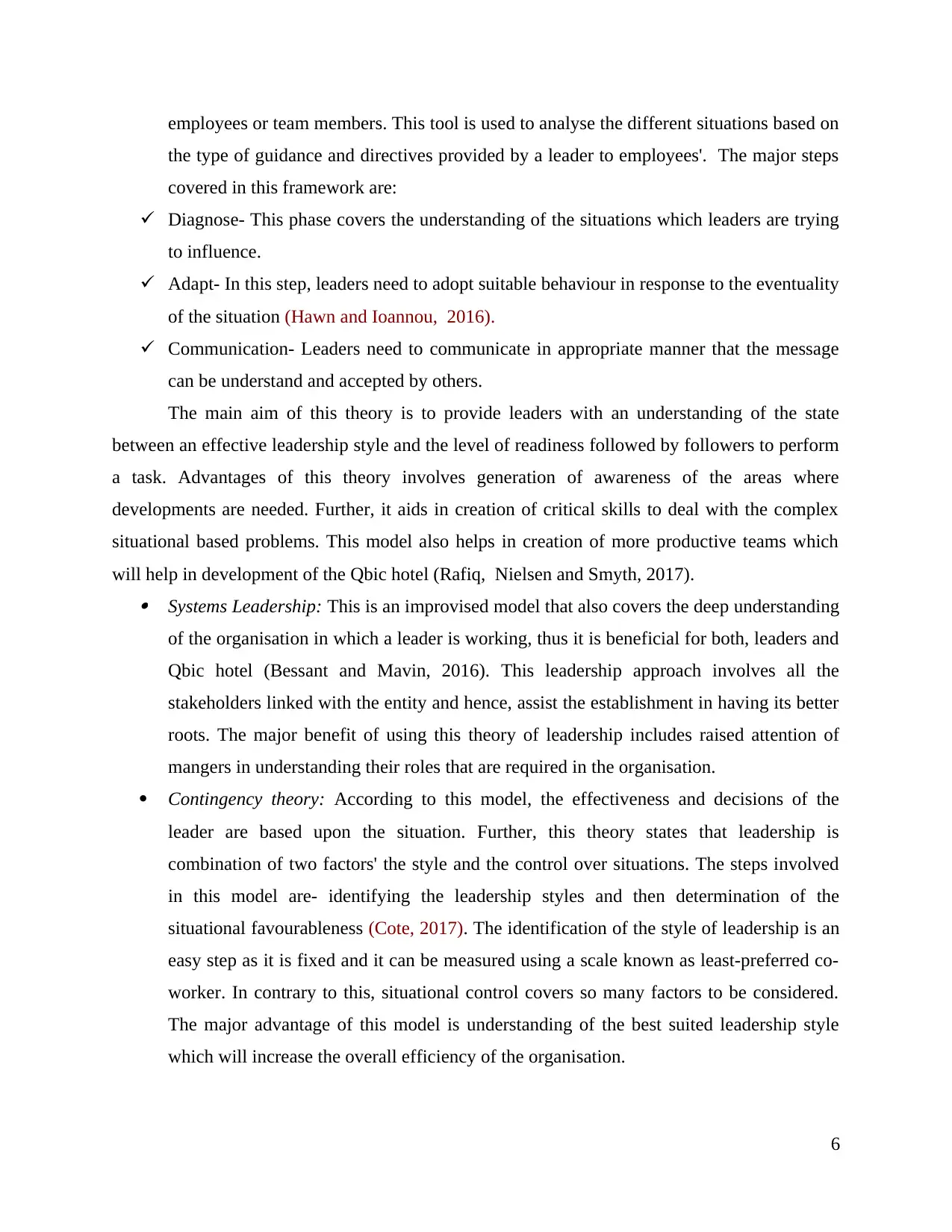
employees or team members. This tool is used to analyse the different situations based on
the type of guidance and directives provided by a leader to employees'. The major steps
covered in this framework are:
Diagnose- This phase covers the understanding of the situations which leaders are trying
to influence.
Adapt- In this step, leaders need to adopt suitable behaviour in response to the eventuality
of the situation (Hawn and Ioannou, 2016).
Communication- Leaders need to communicate in appropriate manner that the message
can be understand and accepted by others.
The main aim of this theory is to provide leaders with an understanding of the state
between an effective leadership style and the level of readiness followed by followers to perform
a task. Advantages of this theory involves generation of awareness of the areas where
developments are needed. Further, it aids in creation of critical skills to deal with the complex
situational based problems. This model also helps in creation of more productive teams which
will help in development of the Qbic hotel (Rafiq, Nielsen and Smyth, 2017). Systems Leadership: This is an improvised model that also covers the deep understanding
of the organisation in which a leader is working, thus it is beneficial for both, leaders and
Qbic hotel (Bessant and Mavin, 2016). This leadership approach involves all the
stakeholders linked with the entity and hence, assist the establishment in having its better
roots. The major benefit of using this theory of leadership includes raised attention of
mangers in understanding their roles that are required in the organisation.
Contingency theory: According to this model, the effectiveness and decisions of the
leader are based upon the situation. Further, this theory states that leadership is
combination of two factors' the style and the control over situations. The steps involved
in this model are- identifying the leadership styles and then determination of the
situational favourableness (Cote, 2017). The identification of the style of leadership is an
easy step as it is fixed and it can be measured using a scale known as least-preferred co-
worker. In contrary to this, situational control covers so many factors to be considered.
The major advantage of this model is understanding of the best suited leadership style
which will increase the overall efficiency of the organisation.
6
the type of guidance and directives provided by a leader to employees'. The major steps
covered in this framework are:
Diagnose- This phase covers the understanding of the situations which leaders are trying
to influence.
Adapt- In this step, leaders need to adopt suitable behaviour in response to the eventuality
of the situation (Hawn and Ioannou, 2016).
Communication- Leaders need to communicate in appropriate manner that the message
can be understand and accepted by others.
The main aim of this theory is to provide leaders with an understanding of the state
between an effective leadership style and the level of readiness followed by followers to perform
a task. Advantages of this theory involves generation of awareness of the areas where
developments are needed. Further, it aids in creation of critical skills to deal with the complex
situational based problems. This model also helps in creation of more productive teams which
will help in development of the Qbic hotel (Rafiq, Nielsen and Smyth, 2017). Systems Leadership: This is an improvised model that also covers the deep understanding
of the organisation in which a leader is working, thus it is beneficial for both, leaders and
Qbic hotel (Bessant and Mavin, 2016). This leadership approach involves all the
stakeholders linked with the entity and hence, assist the establishment in having its better
roots. The major benefit of using this theory of leadership includes raised attention of
mangers in understanding their roles that are required in the organisation.
Contingency theory: According to this model, the effectiveness and decisions of the
leader are based upon the situation. Further, this theory states that leadership is
combination of two factors' the style and the control over situations. The steps involved
in this model are- identifying the leadership styles and then determination of the
situational favourableness (Cote, 2017). The identification of the style of leadership is an
easy step as it is fixed and it can be measured using a scale known as least-preferred co-
worker. In contrary to this, situational control covers so many factors to be considered.
The major advantage of this model is understanding of the best suited leadership style
which will increase the overall efficiency of the organisation.
6
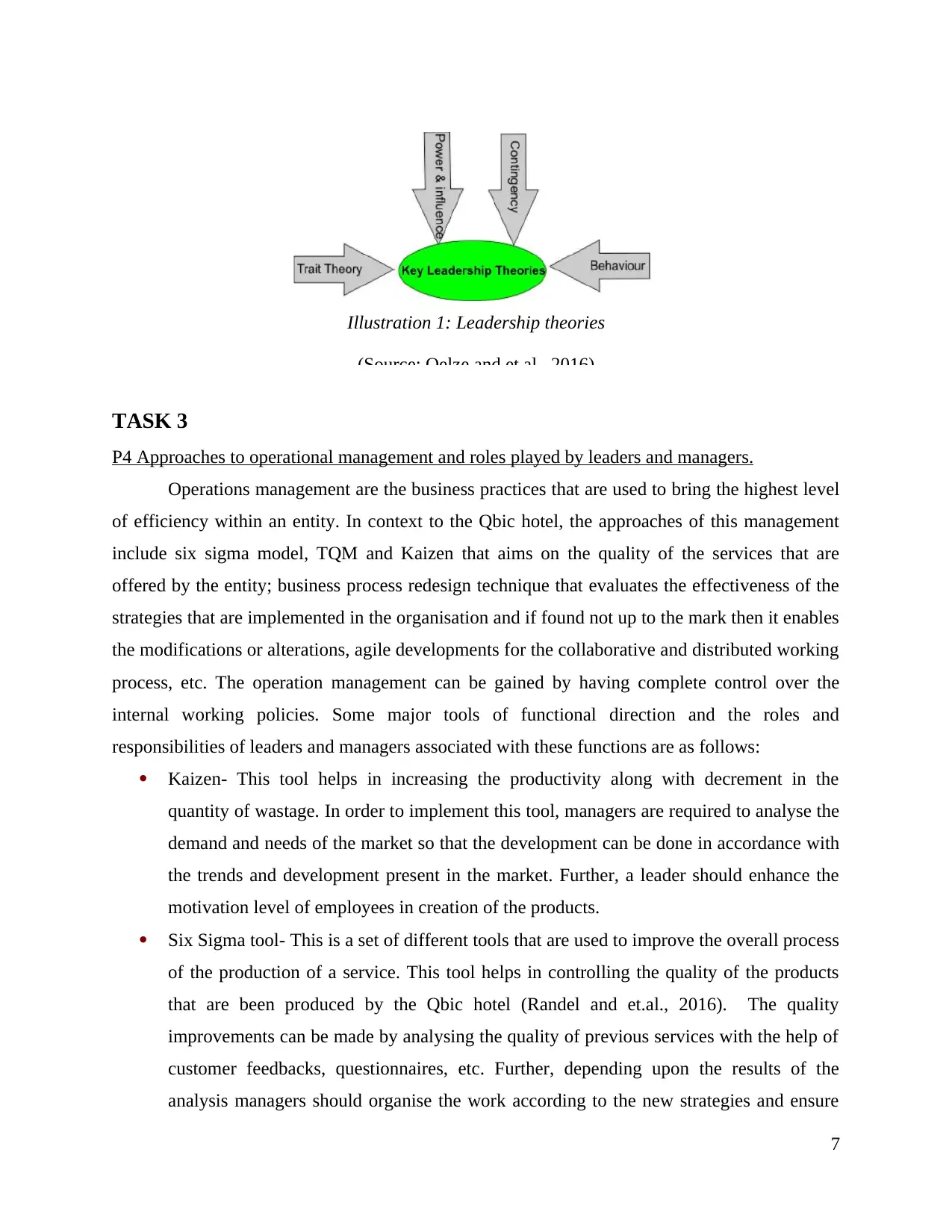
TASK 3
P4 Approaches to operational management and roles played by leaders and managers.
Operations management are the business practices that are used to bring the highest level
of efficiency within an entity. In context to the Qbic hotel, the approaches of this management
include six sigma model, TQM and Kaizen that aims on the quality of the services that are
offered by the entity; business process redesign technique that evaluates the effectiveness of the
strategies that are implemented in the organisation and if found not up to the mark then it enables
the modifications or alterations, agile developments for the collaborative and distributed working
process, etc. The operation management can be gained by having complete control over the
internal working policies. Some major tools of functional direction and the roles and
responsibilities of leaders and managers associated with these functions are as follows:
Kaizen- This tool helps in increasing the productivity along with decrement in the
quantity of wastage. In order to implement this tool, managers are required to analyse the
demand and needs of the market so that the development can be done in accordance with
the trends and development present in the market. Further, a leader should enhance the
motivation level of employees in creation of the products.
Six Sigma tool- This is a set of different tools that are used to improve the overall process
of the production of a service. This tool helps in controlling the quality of the products
that are been produced by the Qbic hotel (Randel and et.al., 2016). The quality
improvements can be made by analysing the quality of previous services with the help of
customer feedbacks, questionnaires, etc. Further, depending upon the results of the
analysis managers should organise the work according to the new strategies and ensure
7
Illustration 1: Leadership theories
(Source: Oelze and et.al., 2016)
P4 Approaches to operational management and roles played by leaders and managers.
Operations management are the business practices that are used to bring the highest level
of efficiency within an entity. In context to the Qbic hotel, the approaches of this management
include six sigma model, TQM and Kaizen that aims on the quality of the services that are
offered by the entity; business process redesign technique that evaluates the effectiveness of the
strategies that are implemented in the organisation and if found not up to the mark then it enables
the modifications or alterations, agile developments for the collaborative and distributed working
process, etc. The operation management can be gained by having complete control over the
internal working policies. Some major tools of functional direction and the roles and
responsibilities of leaders and managers associated with these functions are as follows:
Kaizen- This tool helps in increasing the productivity along with decrement in the
quantity of wastage. In order to implement this tool, managers are required to analyse the
demand and needs of the market so that the development can be done in accordance with
the trends and development present in the market. Further, a leader should enhance the
motivation level of employees in creation of the products.
Six Sigma tool- This is a set of different tools that are used to improve the overall process
of the production of a service. This tool helps in controlling the quality of the products
that are been produced by the Qbic hotel (Randel and et.al., 2016). The quality
improvements can be made by analysing the quality of previous services with the help of
customer feedbacks, questionnaires, etc. Further, depending upon the results of the
analysis managers should organise the work according to the new strategies and ensure
7
Illustration 1: Leadership theories
(Source: Oelze and et.al., 2016)
⊘ This is a preview!⊘
Do you want full access?
Subscribe today to unlock all pages.

Trusted by 1+ million students worldwide
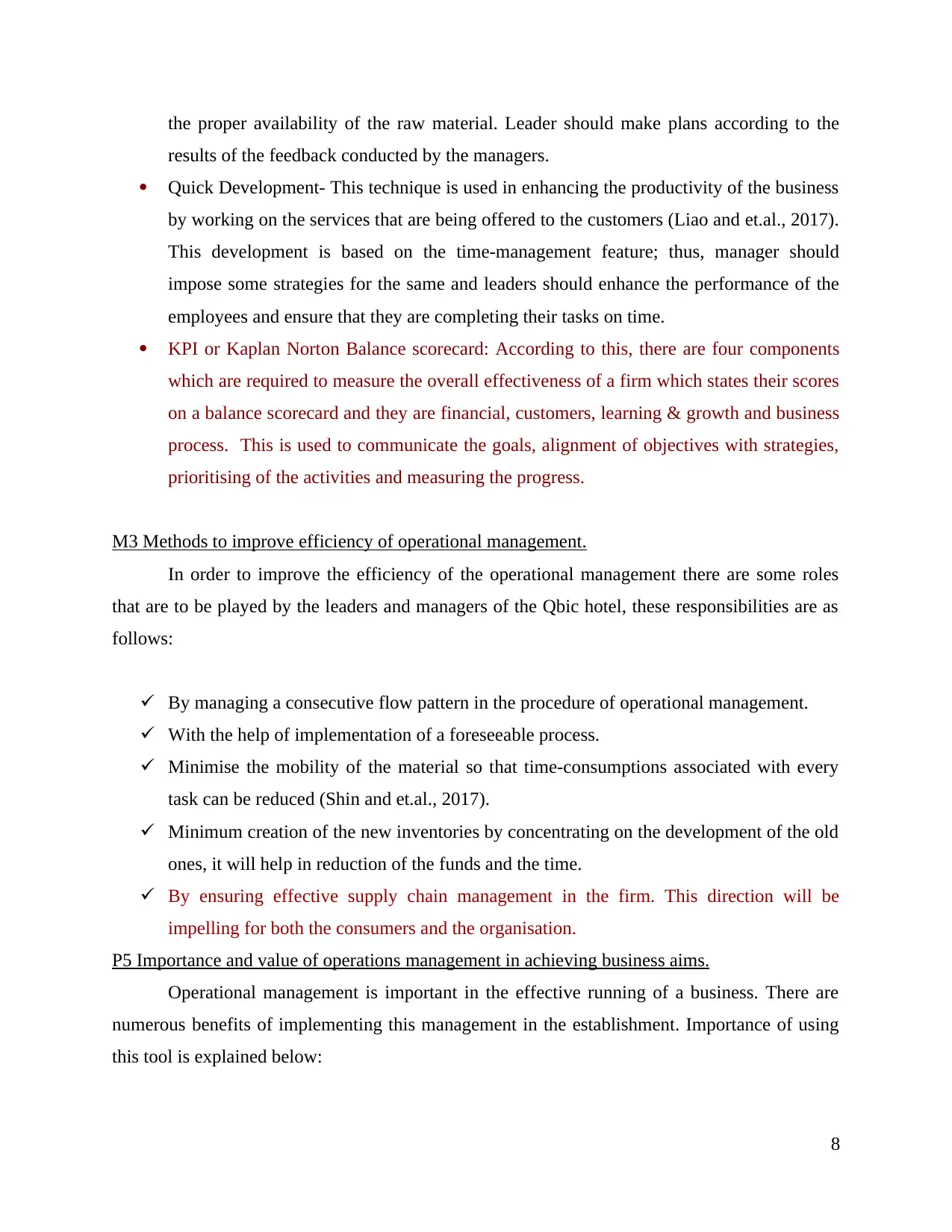
the proper availability of the raw material. Leader should make plans according to the
results of the feedback conducted by the managers.
Quick Development- This technique is used in enhancing the productivity of the business
by working on the services that are being offered to the customers (Liao and et.al., 2017).
This development is based on the time-management feature; thus, manager should
impose some strategies for the same and leaders should enhance the performance of the
employees and ensure that they are completing their tasks on time.
KPI or Kaplan Norton Balance scorecard: According to this, there are four components
which are required to measure the overall effectiveness of a firm which states their scores
on a balance scorecard and they are financial, customers, learning & growth and business
process. This is used to communicate the goals, alignment of objectives with strategies,
prioritising of the activities and measuring the progress.
M3 Methods to improve efficiency of operational management.
In order to improve the efficiency of the operational management there are some roles
that are to be played by the leaders and managers of the Qbic hotel, these responsibilities are as
follows:
By managing a consecutive flow pattern in the procedure of operational management.
With the help of implementation of a foreseeable process.
Minimise the mobility of the material so that time-consumptions associated with every
task can be reduced (Shin and et.al., 2017).
Minimum creation of the new inventories by concentrating on the development of the old
ones, it will help in reduction of the funds and the time.
By ensuring effective supply chain management in the firm. This direction will be
impelling for both the consumers and the organisation.
P5 Importance and value of operations management in achieving business aims.
Operational management is important in the effective running of a business. There are
numerous benefits of implementing this management in the establishment. Importance of using
this tool is explained below:
8
results of the feedback conducted by the managers.
Quick Development- This technique is used in enhancing the productivity of the business
by working on the services that are being offered to the customers (Liao and et.al., 2017).
This development is based on the time-management feature; thus, manager should
impose some strategies for the same and leaders should enhance the performance of the
employees and ensure that they are completing their tasks on time.
KPI or Kaplan Norton Balance scorecard: According to this, there are four components
which are required to measure the overall effectiveness of a firm which states their scores
on a balance scorecard and they are financial, customers, learning & growth and business
process. This is used to communicate the goals, alignment of objectives with strategies,
prioritising of the activities and measuring the progress.
M3 Methods to improve efficiency of operational management.
In order to improve the efficiency of the operational management there are some roles
that are to be played by the leaders and managers of the Qbic hotel, these responsibilities are as
follows:
By managing a consecutive flow pattern in the procedure of operational management.
With the help of implementation of a foreseeable process.
Minimise the mobility of the material so that time-consumptions associated with every
task can be reduced (Shin and et.al., 2017).
Minimum creation of the new inventories by concentrating on the development of the old
ones, it will help in reduction of the funds and the time.
By ensuring effective supply chain management in the firm. This direction will be
impelling for both the consumers and the organisation.
P5 Importance and value of operations management in achieving business aims.
Operational management is important in the effective running of a business. There are
numerous benefits of implementing this management in the establishment. Importance of using
this tool is explained below:
8
Paraphrase This Document
Need a fresh take? Get an instant paraphrase of this document with our AI Paraphraser
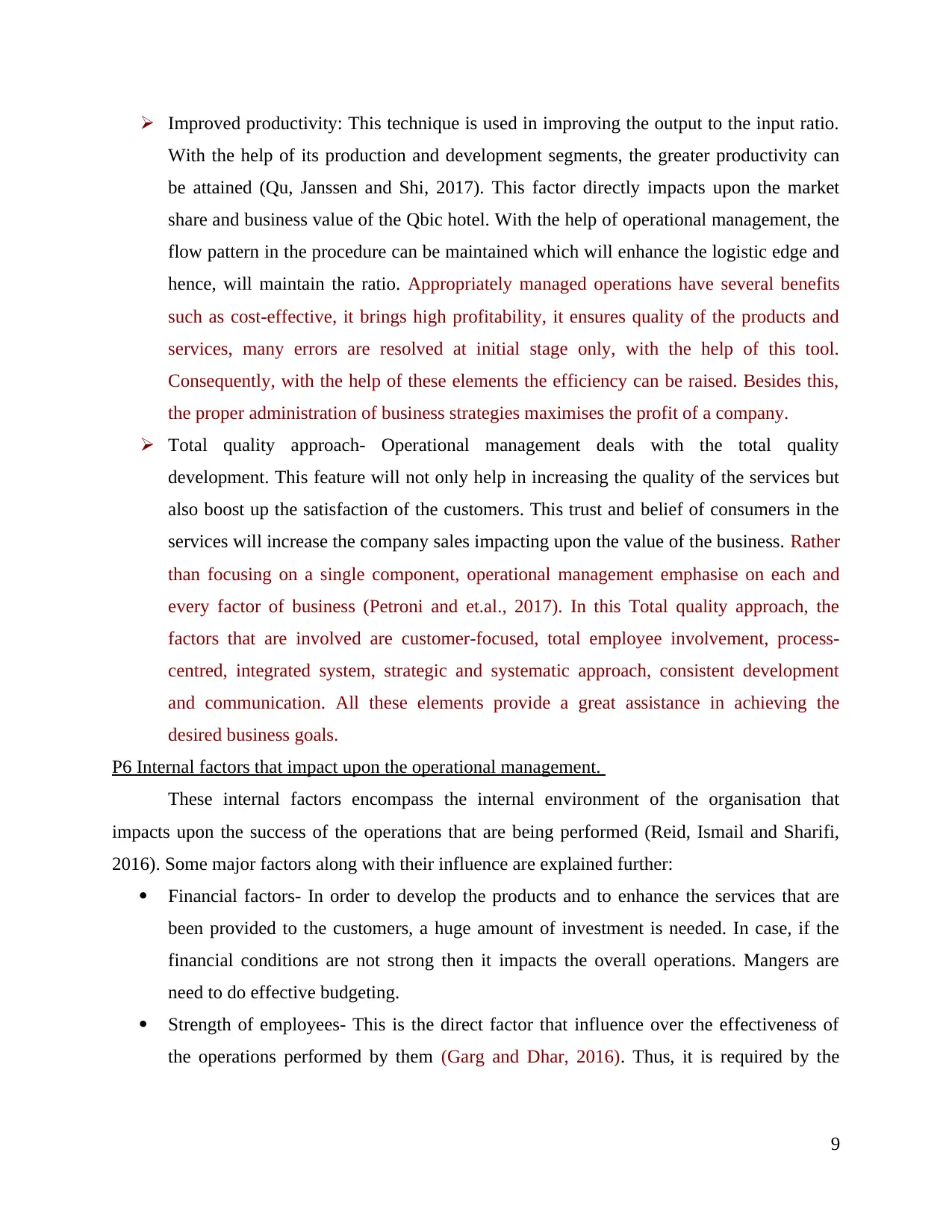
Improved productivity: This technique is used in improving the output to the input ratio.
With the help of its production and development segments, the greater productivity can
be attained (Qu, Janssen and Shi, 2017). This factor directly impacts upon the market
share and business value of the Qbic hotel. With the help of operational management, the
flow pattern in the procedure can be maintained which will enhance the logistic edge and
hence, will maintain the ratio. Appropriately managed operations have several benefits
such as cost-effective, it brings high profitability, it ensures quality of the products and
services, many errors are resolved at initial stage only, with the help of this tool.
Consequently, with the help of these elements the efficiency can be raised. Besides this,
the proper administration of business strategies maximises the profit of a company.
Total quality approach- Operational management deals with the total quality
development. This feature will not only help in increasing the quality of the services but
also boost up the satisfaction of the customers. This trust and belief of consumers in the
services will increase the company sales impacting upon the value of the business. Rather
than focusing on a single component, operational management emphasise on each and
every factor of business (Petroni and et.al., 2017). In this Total quality approach, the
factors that are involved are customer-focused, total employee involvement, process-
centred, integrated system, strategic and systematic approach, consistent development
and communication. All these elements provide a great assistance in achieving the
desired business goals.
P6 Internal factors that impact upon the operational management.
These internal factors encompass the internal environment of the organisation that
impacts upon the success of the operations that are being performed (Reid, Ismail and Sharifi,
2016). Some major factors along with their influence are explained further:
Financial factors- In order to develop the products and to enhance the services that are
been provided to the customers, a huge amount of investment is needed. In case, if the
financial conditions are not strong then it impacts the overall operations. Mangers are
need to do effective budgeting.
Strength of employees- This is the direct factor that influence over the effectiveness of
the operations performed by them (Garg and Dhar, 2016). Thus, it is required by the
9
With the help of its production and development segments, the greater productivity can
be attained (Qu, Janssen and Shi, 2017). This factor directly impacts upon the market
share and business value of the Qbic hotel. With the help of operational management, the
flow pattern in the procedure can be maintained which will enhance the logistic edge and
hence, will maintain the ratio. Appropriately managed operations have several benefits
such as cost-effective, it brings high profitability, it ensures quality of the products and
services, many errors are resolved at initial stage only, with the help of this tool.
Consequently, with the help of these elements the efficiency can be raised. Besides this,
the proper administration of business strategies maximises the profit of a company.
Total quality approach- Operational management deals with the total quality
development. This feature will not only help in increasing the quality of the services but
also boost up the satisfaction of the customers. This trust and belief of consumers in the
services will increase the company sales impacting upon the value of the business. Rather
than focusing on a single component, operational management emphasise on each and
every factor of business (Petroni and et.al., 2017). In this Total quality approach, the
factors that are involved are customer-focused, total employee involvement, process-
centred, integrated system, strategic and systematic approach, consistent development
and communication. All these elements provide a great assistance in achieving the
desired business goals.
P6 Internal factors that impact upon the operational management.
These internal factors encompass the internal environment of the organisation that
impacts upon the success of the operations that are being performed (Reid, Ismail and Sharifi,
2016). Some major factors along with their influence are explained further:
Financial factors- In order to develop the products and to enhance the services that are
been provided to the customers, a huge amount of investment is needed. In case, if the
financial conditions are not strong then it impacts the overall operations. Mangers are
need to do effective budgeting.
Strength of employees- This is the direct factor that influence over the effectiveness of
the operations performed by them (Garg and Dhar, 2016). Thus, it is required by the
9
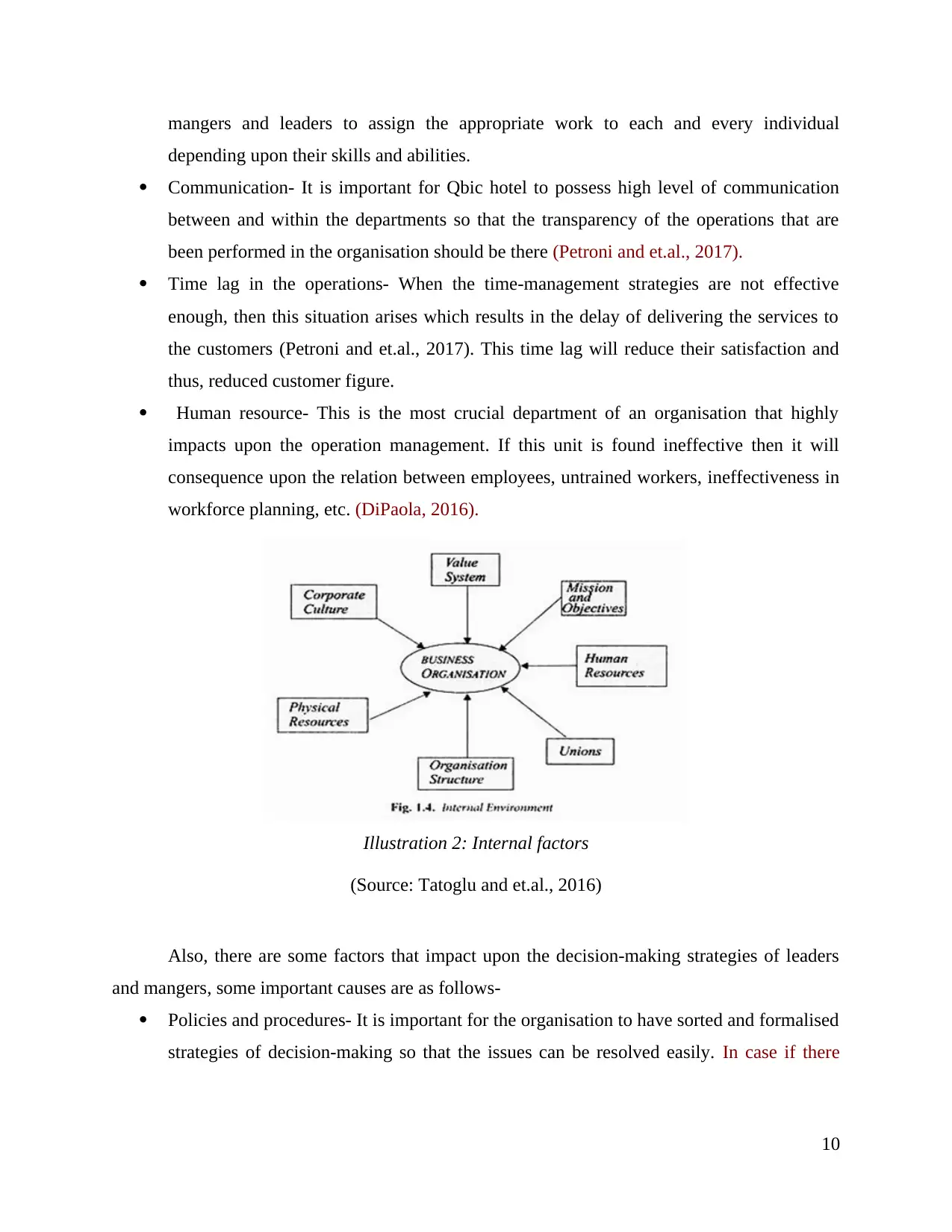
mangers and leaders to assign the appropriate work to each and every individual
depending upon their skills and abilities.
Communication- It is important for Qbic hotel to possess high level of communication
between and within the departments so that the transparency of the operations that are
been performed in the organisation should be there (Petroni and et.al., 2017).
Time lag in the operations- When the time-management strategies are not effective
enough, then this situation arises which results in the delay of delivering the services to
the customers (Petroni and et.al., 2017). This time lag will reduce their satisfaction and
thus, reduced customer figure.
Human resource- This is the most crucial department of an organisation that highly
impacts upon the operation management. If this unit is found ineffective then it will
consequence upon the relation between employees, untrained workers, ineffectiveness in
workforce planning, etc. (DiPaola, 2016).
Also, there are some factors that impact upon the decision-making strategies of leaders
and mangers, some important causes are as follows-
Policies and procedures- It is important for the organisation to have sorted and formalised
strategies of decision-making so that the issues can be resolved easily. In case if there
10
Illustration 2: Internal factors
(Source: Tatoglu and et.al., 2016)
depending upon their skills and abilities.
Communication- It is important for Qbic hotel to possess high level of communication
between and within the departments so that the transparency of the operations that are
been performed in the organisation should be there (Petroni and et.al., 2017).
Time lag in the operations- When the time-management strategies are not effective
enough, then this situation arises which results in the delay of delivering the services to
the customers (Petroni and et.al., 2017). This time lag will reduce their satisfaction and
thus, reduced customer figure.
Human resource- This is the most crucial department of an organisation that highly
impacts upon the operation management. If this unit is found ineffective then it will
consequence upon the relation between employees, untrained workers, ineffectiveness in
workforce planning, etc. (DiPaola, 2016).
Also, there are some factors that impact upon the decision-making strategies of leaders
and mangers, some important causes are as follows-
Policies and procedures- It is important for the organisation to have sorted and formalised
strategies of decision-making so that the issues can be resolved easily. In case if there
10
Illustration 2: Internal factors
(Source: Tatoglu and et.al., 2016)
⊘ This is a preview!⊘
Do you want full access?
Subscribe today to unlock all pages.

Trusted by 1+ million students worldwide
1 out of 15
Related Documents
Your All-in-One AI-Powered Toolkit for Academic Success.
+13062052269
info@desklib.com
Available 24*7 on WhatsApp / Email
![[object Object]](/_next/static/media/star-bottom.7253800d.svg)
Unlock your academic potential
Copyright © 2020–2025 A2Z Services. All Rights Reserved. Developed and managed by ZUCOL.





